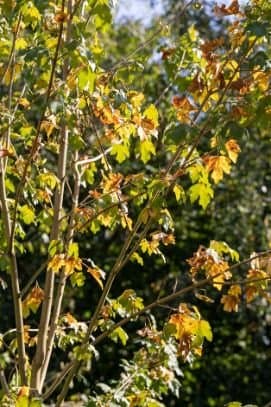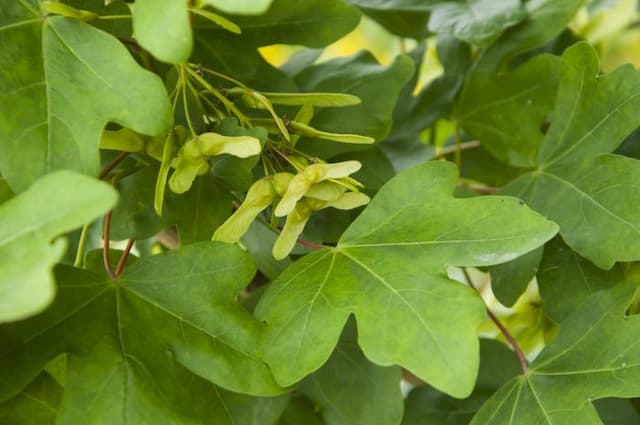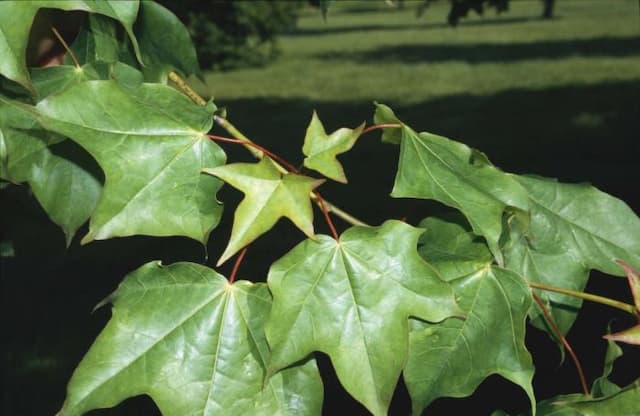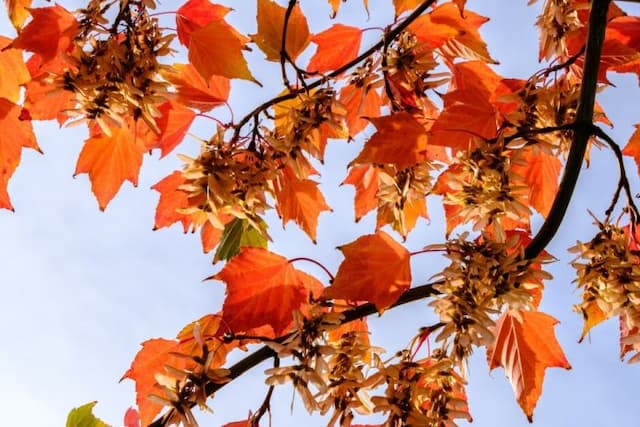Norway Maple Acer platanoides 'Columnare'

ABOUT
The Norway maple 'Columnare' is a cultivated variety of the Norway maple tree known for its unique columnar growth habit. This tree is characterized by a narrow, upright structure that resembles a tall column. Its foliage consists of large, lobed leaves that are typically a rich, glossy green. The leaves are arranged in a way that creates a dense canopy. In the spring, this tree produces small, attractive flowers which eventually give way to samaras, commonly referred to as helicopter seeds or winged seeds, due to their distinctive shape that allows them to be carried away by the wind. The bark of this tree is gray-brown with a slightly ridged and furrowed texture, adding to its ornamental value. During the autumn season, the leaves transition into a brilliant display of yellows, often with hints of gold and sometimes red, giving the landscape a striking and striking splash of color.
About this plant
 Names
NamesFamily
Sapindaceae
Synonyms
Columnar Norway Maple
Common names
Acer platanoides 'Columnare'
 Toxicity
ToxicityTo humans
Norway Maple, specifically the cultivar 'Columnare', is not known for its toxicity to humans. There are generally no serious symptoms of poisoning associated with this plant since it is not commonly regarded as toxic. Therefore, ingesting parts of the Norway Maple, including the 'Columnare' variety, does not typically result in any significant toxic consequences for humans.
To pets
Norway Maple, including the 'Columnare' cultivar, is not known to be toxic to pets. It is not typically associated with any serious symptoms of poisoning in animals such as dogs and cats. Thus, ingestion of parts of the Norway Maple generally does not lead to significant toxicological effects in pets.
 Characteristics
CharacteristicsLife cycle
Perennials
Foliage type
Deciduous
Color of leaves
Green
Flower color
Yellow
Height
40-50 feet (12-15 meters)
Spread
10-15 feet (3-4.5 meters)
Plant type
Tree
Hardiness zones
3-7
Native area
Europe
Benefits
 General Benefits
General Benefits- Ornamental Value: Acer platanoides 'Columnare', commonly known as Norway Maple, has a distinct columnar form which adds structural interest to landscapes.
- Shade Provider: Its dense canopy offers ample shade during the summer months, making it ideal for parks and large gardens.
- Autumn Foliage: The tree displays vibrant yellow fall color, enhancing the aesthetic appeal of an area in the autumn season.
- Hardiness: Norway Maple is known for its ability to withstand cold temperatures, making it suitable for a variety of climates.
- Urban Tolerance: It is tolerant of pollution and compacted soil, which is beneficial in urban and roadside environments.
- Wildlife Support: The tree can provide habitat and food sources for birds and other wildlife.
- Drought Resistance: Once established, Acer platanoides 'Columnare' shows moderate resistance to drought conditions.
- Low Maintenance: Norway Maple generally requires minimal upkeep apart from occasional pruning and is thus suitable for low-maintenance landscaping.
 Medical Properties
Medical PropertiesThis plant is not used for medical purposes.
 Air-purifying Qualities
Air-purifying QualitiesThis plant is not specifically known for air purifying qualities.
 Other Uses
Other Uses- Acer platanoides 'Columnare', commonly known as Norway Maple, can be used in woodworking and carpentry. Its wood is appreciated for its hardness and can be crafted into furniture and musical instruments.
- The dense canopy of the Norway Maple offers a sound barrier to reduce noise pollution in urban environments when planted in rows along streets or highways.
- The sap of Norway Maple can be used as a substitute for sugaring, similar to that of the Sugar Maple, although it is less sweet and requires more sap to produce maple syrup.
- Norway Maple can serve as a host plant for the larvae of certain butterfly species, thus can be used to support local butterfly populations in conservation efforts.
- The tree can be planted to stabilize soil and prevent erosion on slopes due to its extensive root system.
- Norway Maple's dense foliage can be used in creating privacy screens or hedges in residential or commercial landscapes.
- The dried leaves of Norway Maple can be crumbled and used as a natural mulch to enrich soil fertility in garden beds.
- The tree is sometimes incorporated into bonsai cultivation for enthusiasts who appreciate its leaf shape and adaptability for training into miniature forms.
- As an ornamental tree, selected varieties of Norway Maple can be planted in alignment to create striking visual patterns in large gardens or parks.
- The color change of Norway Maple foliage in the autumn provides aesthetic value and is used to enhance the seasonal interest in landscape designs.
Interesting Facts
 Feng Shui
Feng ShuiThe Norway Maple is not used in Feng Shui practice.
 Zodiac Sign Compitability
Zodiac Sign CompitabilityThe Norway Maple is not used in astrology practice.
 Plant Symbolism
Plant Symbolism- Strength and Endurance: As a hardy species, the Norway Maple ('Columnare' being a cultivar) often symbolizes strength and the ability to withstand challenging conditions.
- Longevity: Trees, in general, are symbols of longevity, and the Norway Maple, with its potential to live for a century or more, is no exception.
- Adaptability: This cultivar has been bred to thrive in various environments, making it a symbol of adaptability and resilience.
- Growth and Expansion: Just as the tree's branches grow outward, it can represent personal growth and the expansion of one's boundaries.
- Beauty and Grace: With its orderly, column-like growth habit and attractive foliage, the Norway Maple can symbolize beauty and a graceful presence.
- Protection: Trees are often seen as protective entities, offering shade and shelter, and the Norway Maple's robust nature embodies this trait.
 Water
WaterThe 'Columnar Norway Maple' should be watered deeply and thoroughly, allowing the water to penetrate the soil to the depth of the root system, which encourages deep root growth. During the growing season, water the tree every week with 1.5 to 2 gallons per inch of trunk diameter at chest height, especially if there is no significant rainfall. In periods of drought or extreme heat, it is important to water more frequently, potentially twice a week. During fall and leading into winter, reduce watering to help the tree acclimate to colder conditions. Newly planted trees require more consistent watering, every few days for the first several weeks, then gradually reduce frequency as the tree becomes established.
 Light
LightThe 'Columnar Norway Maple' thrives in full sun to partial shade. It performs best when it receives at least 4 hours of direct sunlight per day. The ideal spot for planting this maple is in a location where it is exposed to morning sunlight and protected from the harsh heat of the late afternoon sun. However, it is versatile and can tolerate a range of light conditions, making it suitable for many landscapes.
 Temperature
TemperatureThe 'Columnar Norway Maple' is hardy and can withstand a broad range of temperatures. It is adaptable to cold, with an ability to survive winter temperatures down to -30°F, while also tolerating summer temperatures up to around 90°F. The ideal temperature range for optimum growth is between 60°F and 75°F. It is important to protect young trees from extreme temperatures by providing appropriate mulch or tree guards.
 Pruning
PruningPruning the 'Columnar Norway Maple' is primarily completed to remove dead or damaged branches, to shape the tree during its formative years, and to maintain its health. The best time for pruning is during the late winter to early spring when the tree is still dormant and before new growth starts. Prune annually to shape the young tree, but once mature, prune it every 2 to 3 years or as required to remove any problematic branches.
 Cleaning
CleaningAs needed
 Soil
SoilThe Norway Maple 'Columnare' prefers a well-draining soil mix with a pH range of 5.5 to 7.5. A combination of loamy soil, compost, and coarse sand or perlite will ensure sufficient drainage and nutrient retention. Regularly check soil pH to maintain the ideal conditions for this tree.
 Repotting
RepottingNorway Maples do not typically require frequent repotting as they are normally planted outdoors. However, if grown in a container, they should be repotted every 3 to 5 years to prevent root binding and replenish nutrients in the soil.
 Humidity & Misting
Humidity & MistingThe Norway Maple 'Columnare' is adaptable to a wide range of humidity levels and does not require specific humidity conditions to thrive. It performs well in the natural outdoor humidity found in its hardiness zones.
 Suitable locations
Suitable locationsIndoor
Not suitable for indoor growth; needs outdoor space.
Outdoor
Plant in full sun to partial shade, well-draining soil.
Hardiness zone
4-7 USDA
 Life cycle
Life cycleThe Norway Maple 'Columnare' begins its life as a seed, which, after a period of dormancy, germinates in the spring when soil temperatures warm up. It then grows into a seedling, developing its first leaves and a root system to absorb water and nutrients. As a sapling, the tree grows rapidly, establishing a strong trunk and branches to support the foliage. Over several years, the Norway Maple 'Columnare' matures into an adult tree, capable of producing flowers that are wind-pollinated, leading to the development of samaras, or winged seeds. These seeds disperse in the vicinity of the parent tree, continuing the cycle when they germinate. Throughout its life, which can span several decades, the tree experiences annual cycles of growth in the spring and summer, followed by a dormant period in the fall and winter when leaves turn vibrant colors before being shed.
 Propogation
PropogationPropogation time
Late winter-early spring
The most popular method of propagating the Norway Maple 'Columnare' is by seed. The best time to collect seeds is when they mature in fall, typically in the time frame of September to October. Once collected, the seeds can be sown immediately in prepared beds outdoors or stratified for spring planting. Stratification involves mixing the seeds with moist sand and storing them in a sealed container in the refrigerator for 90-120 days, which mimics winter conditions and helps to break seed dormancy. After stratification, seeds can be sown in pots or directly in the ground during spring. When sowing, cover the seeds with soil to a depth of approximately a quarter of an inch (6.35 millimeters) and keep the soil moist but not waterlogged until germination, which generally occurs in 1-2 weeks if temperatures are around 70 degrees Fahrenheit (21 degrees Celsius). Seedlings should be gradually acclimatized to outdoor conditions before planting in their permanent location.







![Freeman maple [Autumn Blaze]](/_next/image?url=https%3A%2F%2Fplants-admin.emdemapps.com%2Fimages%2Fplants%2F%2Fimages%2F604b575b84d87.png&w=640&q=75)

